 General
General  General Archive
General Archive  Dusting Off Our Jackets
Dusting Off Our Jackets
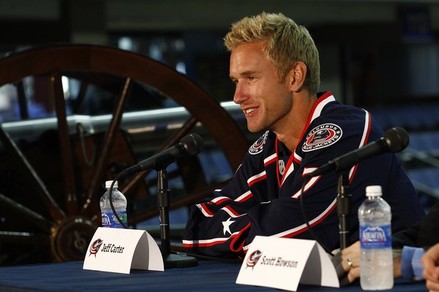 Some familiar faces are still around in the state capital, but it is the new faces that will have to carry the flag for the team this season if they wish to make the playoffs. The Columbus Blue Jackets enter the 2011-12 campaign with a lot of optimism and with good reason. Offseason acquisitions of Jeff Carter, James Wisniewski, Vaclav Prospal, and Radek Martinek have made this the strongest group the Blue Jackets have had in the franchise’s history. One new face whose fate has yet to be determined is that of Ryan Johansen and he could be the key to the season for the team.
Some familiar faces are still around in the state capital, but it is the new faces that will have to carry the flag for the team this season if they wish to make the playoffs. The Columbus Blue Jackets enter the 2011-12 campaign with a lot of optimism and with good reason. Offseason acquisitions of Jeff Carter, James Wisniewski, Vaclav Prospal, and Radek Martinek have made this the strongest group the Blue Jackets have had in the franchise’s history. One new face whose fate has yet to be determined is that of Ryan Johansen and he could be the key to the season for the team.
The Blue Jackets won at home and lost on the road during the first preseason night against the Winnipeg Jets. It was a split-squad game, something I have never seen before in the NHL preseason. The most concerning development of the day was a lower body injury to new backup goaltender Mark Dekanich. While projected AHL starter Curtis Sanford had a miniscule 1.93 goals against average with Hamilton last season, he has not been able to be a regular NHL backup over his 11 professional seasons. Dekanich has potential at just 25 years old. A long-term injury to Dekanich would require the Jackets to search for experienced goaltenders or bide their time until cuts start coming from other training camps. Leg injuries can really linger for goaltenders so this is a concern.
In any event, the Blue Jackets main components are set in stone, but other players will be using training camp to try and solidify their attempts to make the team. There are important position battles in preseason because injuries are inevitable. Here are some of the names to keep an eye on that may fly under the radar:
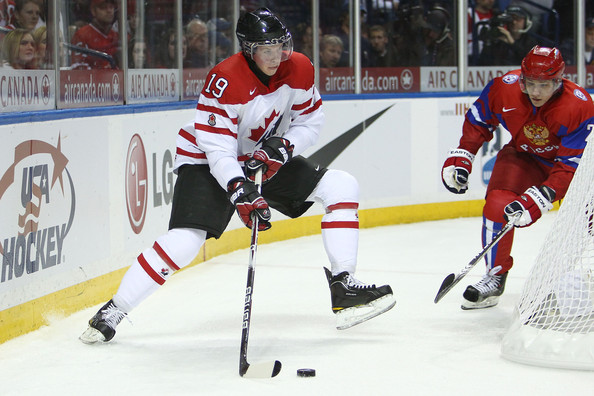
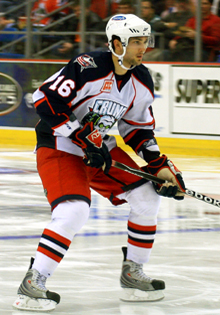 In terms of forwards, the biggest names to keep an eye on are Ryan Johansen and Maxim Mayorov. Johansen, the team’s
In terms of forwards, the biggest names to keep an eye on are Ryan Johansen and Maxim Mayorov. Johansen, the team’s
first round pick in 2010, has a large frame and his skill set could be the key to the Blue Jackets success. The reason I think Johansen is so paramount to the team’s success is because the Blue Jackets lack scoring depth. If Johansen makes the team, he either allows the team to keep Jeff Carter and Rick Nash together as one dynamic scoring line or split the two up and have two good scorers in their top two lines. Johansen is the kind of player Columbus has lacked because he is a big bodied center who has the talent level to play alongside Rick Nash.
Mayorov, on the other hand, is the type of player who the Blue Jackets have had trouble with. Whether it is Kristian Huselius’s injury issues or Nikita Filatov’s lack of work ethic and hockey awareness, the Blue Jackets have been devoid of a fast, talented, top notch skater capable of playing a flashy, yet responsible, skill game. What Mayorov brings to the table is a player who can create open ice for his linemates based on speed.
I was down at Blue Jackets training camp on Sunday and walked away impressed with these two. Anybody who watches the Blue Jackets regularly knows how Rick Nash is able to shield defenders from the puck by establishing body position between the defender and the puck. It is an undervalued skill in the NHL because puck possession is so crucial, yet overlooked. Johansen has this ability. The longer a player controls the puck in the offensive zone, the better chance that his teammates can find open space. A good portion of Rick Nash’s assists come this way.
What will determine Johansen’s fate is the ability to showcase this skill. The biggest difference between playing juniors and making the step to the big leagues is to adapt to the strength and skating ability of the opposition. There are kids all over the junior ranks who can flat out fly and have supreme balance on their edges. The problem is that when they get pressured or have the opponent play physical against them, they fall like a house of cards in front of an industrial fan. Last year, Johansen was too light on his skates and not strong enough. This year, he looked bigger and more mature physically.
On the flip side, Mayorov is an altogether different type of player. Mayorov would have to protect the puck with speed and agility, using deception and quickness to elude defenders. Players like Mayorov need to display good hands and strong defensive positioning to survive. Mayorov has those tools.
I’ll elaborate this point based on what I saw on Sunday. Mayorov has tremendous straight line speed. If he makes the team, he will be a top two or three skater. While standing in the high slot, the area between the faceoff circles, one of his linemates turned the puck over. A player with low awareness would either circle down after the puck looking to create a turnover or stand still or look for a bad pass. At the level that Mayorov is playing at, defensemen make very few bad passes. So, instead of being reactive, Mayorov was proactive. One of the cardinal rules of hockey in the defensive zone is to “keep your head on a swivel”. This is so you are constantly aware of what the player you are responsible for is doing. Mayorov looked around, found his man, and shadowed him into the neutral zone. Plays like that are the difference between being shipped to Springfield of the AHL and finding an apartment in Columbus.
The beauty of training camp is watching players who are on the bubble give some extra effort. Some guys stood out whose tickets are already punched to Springfield or back to their junior teams. However, they left an impression in the case of injuries. Hockey is about doing the little things. Giving 115% in training camp instead of 110% is one of those little things. Coaching staffs notice.
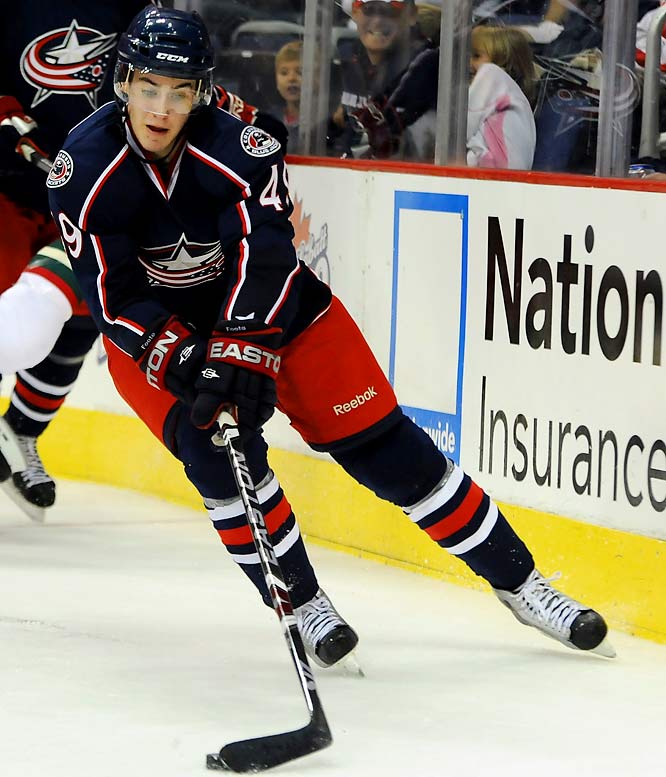
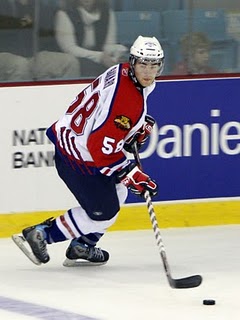 In terms of defensemen looking to make a mark, there are two who are on everybody’s radar – John Moore and David Savard. Moore has had high expectations since being drafted in the first round of the 2009 draft and has yet to live up to them. The Blue Jackets tried to expedite his development by playing him in Springfield last year, but he struggled with the transition. In his first pro season, Moore was a -27 in Springfield. There are a vocal minority who downplay plus/minus statistics because it is not exactly an individual assessment. More of a problem for Moore is his size. His body type, tall and a little lanky, does not seem to be one that is conducive to the rigors of being a NHL defenseman. He has to show an ability to handle that type of game before he will wear a Jackets sweater.
In terms of defensemen looking to make a mark, there are two who are on everybody’s radar – John Moore and David Savard. Moore has had high expectations since being drafted in the first round of the 2009 draft and has yet to live up to them. The Blue Jackets tried to expedite his development by playing him in Springfield last year, but he struggled with the transition. In his first pro season, Moore was a -27 in Springfield. There are a vocal minority who downplay plus/minus statistics because it is not exactly an individual assessment. More of a problem for Moore is his size. His body type, tall and a little lanky, does not seem to be one that is conducive to the rigors of being a NHL defenseman. He has to show an ability to handle that type of game before he will wear a Jackets sweater.
David Savard could be more poised to handle the physicality of the NHL game. At 6’2” 214, he is more proportional and also has the benefit over Moore of being a right handed shot. The Blue Jackets have been left-handed heavy in recent times and Savard could fill a more immediate need. He has an astonishing 64 assists in his final year of junior hockey before playing for Springfield last year.
The ultimate purpose of training camp, besides getting in shape, is to establish depth. Having these four players available, even if they do not make the big club, is very beneficial. They will be among the final cuts, though Moore and Savard are almost guaranteed to be sent to Springfield barring injury.
One final thing that I noticed from Sunday’s Owner’s Tournament scrimmage is that the Blue Jackets drafting philosophy has greatly improved over the last few seasons. Rather than take chances with skilled, relatively one-dimensional forwards and safe defensive defensemen, the team is drafting more complete players with better size and more awareness. Winning teams are not necessarily built on skill, but built on intelligence. Skill has to be a part of it, but if you look at the last few Stanley Cup winners, there are a lot of intelligent role players who are integral components of their team’s playoff run. This is not by coincidence. Skill can be neutralized. Hockey IQ and awareness cannot. Neither can size.
As I said further up, there is a lot of optimism for this season. Sunday’s scrimmages filled the Ice Haus practice facility to the brim. Combine a new arena agreement with the struggles of the Ohio State Buckeyes and you could have a perfect storm for the Blue Jackets organization. The team looks to be on the upswing. They had their most successful offseason in quite some time, with a lot of positive press, and have cemented themselves as a long-term part of the city’s sports landscape.
With the NBA in a lockout, the Buckeyes struggling, and a hockey resurgence thanks to the lockout, the momentum of the 2010 Olympics, and a very entertaining 2011 Stanley Cup playoffs, there’s no shortage of reasons to be excited about the 2011-12 Blue Jackets season.
- NBA Announces 2013-2014 Schedule
- Browns Ink Sharknado
- Sharknado A No-Show For Rookie Camp
- Trent Richardson Out Until Training Camp
- Browns Sign Brandon Jackson
- Carrasco Suspended Eight Games
- Browns Add to Wide Receiver Depth with David Nelson
- Browns Need to Learn from Past Draft Mistakes
- Browns Release Chris Gocong and Usama Young
- Browns Missing on Grimes Disappointing, But Not The End
The TCF Forums
- Movies coming out
rebelwithoutaclue (Tuesday, January 21 2014 12:56 PM) - 2015 Recruiting
jclvd_23 (Tuesday, January 21 2014 12:38 PM) - The 2014 Offseason Thread
Larvell Blanks (Tuesday, January 21 2014 12:25 PM) - Official- Browns Coach Search/Rumors
Larvell Blanks (Tuesday, January 21 2014 11:53 AM) - Chris Grant's first 3 drafts
Kingpin74 (Tuesday, January 21 2014 10:13 AM) - Mike Brown
YahooFanChicago (Monday, January 20 2014 11:15 PM) - 2014 Hoops Hockey Hijinx
jpd1224 (Monday, January 20 2014 4:44 PM) - 2014 Recruiting
jclvd_23 (Monday, January 20 2014 2:26 PM) - Wish List - #4 Pick
Hikohadon (Monday, January 20 2014 1:26 PM) - #1 overall pick Anthony Bennett
TouchEmAllTime (Sunday, January 19 2014 1:28 PM)



